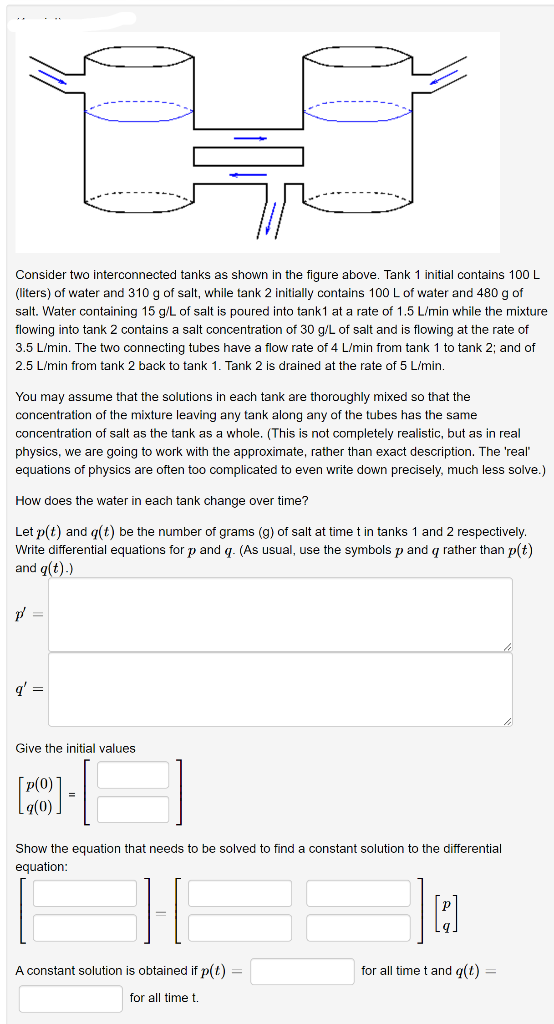Consider two interconnected tanks as shown in the figure above. Tank 1 initial contains 10 (liters) of water and 310 g of salt, while tank 2 initially contains 100 L of water and 480 g o salt. Water containing 15 g/L of salt is poured into tank1 at a rate of 1.5 L/min while the mi flowing into tank 2 contains a salt concentration of 30 g/L of salt and is flowing at the rate c 3.5 L/min. The two connecting tubes have a flow rate of 4 L/min from tank 1 to tank 2; and 2.5 L/min from tank 2 back to tank 1. Tank 2 is drained at the rate of 5 Limin. You may assume that the solutions in each tank are thoroughly mixed so that the concentration of the mixture leaving any tank along any of the tubes has the same concentration of salt as the tank as a whole. (This is not completely realistic, but as in real physics, we are going to work with the approximate, rather than exact description. The 'rea equations of physics are often too complicated to even write down precisely, much less so How does the water each tank change over time? Let p(t) and g(t) be the number of grams (g) of salt at time t in tanks 1 and 2 respectively Write differential equations for p and q. (As usual, use the symbols p and g rather than p( and q(t).) q' = Give the initial values Show the equation that needs to be solved to find a constant solution to the differential equation: Ja A constant solution is obtained if p(t) = for all time t and q(t) for all time t.
Consider two interconnected tanks as shown in the figure above. Tank 1 initial contains 10 (liters) of water and 310 g of salt, while tank 2 initially contains 100 L of water and 480 g o salt. Water containing 15 g/L of salt is poured into tank1 at a rate of 1.5 L/min while the mi flowing into tank 2 contains a salt concentration of 30 g/L of salt and is flowing at the rate c 3.5 L/min. The two connecting tubes have a flow rate of 4 L/min from tank 1 to tank 2; and 2.5 L/min from tank 2 back to tank 1. Tank 2 is drained at the rate of 5 Limin. You may assume that the solutions in each tank are thoroughly mixed so that the concentration of the mixture leaving any tank along any of the tubes has the same concentration of salt as the tank as a whole. (This is not completely realistic, but as in real physics, we are going to work with the approximate, rather than exact description. The 'rea equations of physics are often too complicated to even write down precisely, much less so How does the water each tank change over time? Let p(t) and g(t) be the number of grams (g) of salt at time t in tanks 1 and 2 respectively Write differential equations for p and q. (As usual, use the symbols p and g rather than p( and q(t).) q' = Give the initial values Show the equation that needs to be solved to find a constant solution to the differential equation: Ja A constant solution is obtained if p(t) = for all time t and q(t) for all time t.
Linear Algebra: A Modern Introduction
4th Edition
ISBN:9781285463247
Author:David Poole
Publisher:David Poole
Chapter2: Systems Of Linear Equations
Section2.4: Applications
Problem 17EQ
Related questions
Question
100%

Transcribed Image Text:Consider two interconnected tanks as shown in the figure above. Tank 1 initial contains 100L
(liters) of water and 310 g of salt, while tank 2 initially contains 100 L of water and 480 g of
salt. Water containing 15 g/L of salt is poured into tank1 at a rate of 1.5 L/min while the mixture
flowing into tank 2 contains a salt concentration of 30 g/L of salt and is flowing at the rate of
3.5 L/min. The two connecting tubes have a flow rate of 4 L/min from tank 1 to tank 2; and of
2.5 L/min from tank 2 back to tank 1. Tank 2 is drained at the rate of 5 L/min.
You may assume that the solutions in each tank are thoroughly mixed so that the
concentration of the mixture leaving any tank along any of the tubes has the same
concentration of salt as the tank as a whole. (This is not completely realistic, but as in real
physics, we are going to work with the approximate, rather than exact description. The 'real
equations of physics are often too complicated to even write down precisely, much less solve.)
How does the water in each tank change over time?
Let p(t) and g(t) be the number of grams (g) of salt at time t in tanks 1 and 2 respectively.
Write differential equations for p and g. (As usual, use the symbols p and q rather than p(t)
and q(t).)
q' =
Give the initial values
Show the equation that needs to be solved to find a constant solution to the differential
equation:
A constant solution is obtained if p(t) =
for all time t and q(t) =
for all time t
Expert Solution
This question has been solved!
Explore an expertly crafted, step-by-step solution for a thorough understanding of key concepts.
This is a popular solution!
Trending now
This is a popular solution!
Step by step
Solved in 6 steps with 1 images

Recommended textbooks for you

Linear Algebra: A Modern Introduction
Algebra
ISBN:
9781285463247
Author:
David Poole
Publisher:
Cengage Learning

Linear Algebra: A Modern Introduction
Algebra
ISBN:
9781285463247
Author:
David Poole
Publisher:
Cengage Learning